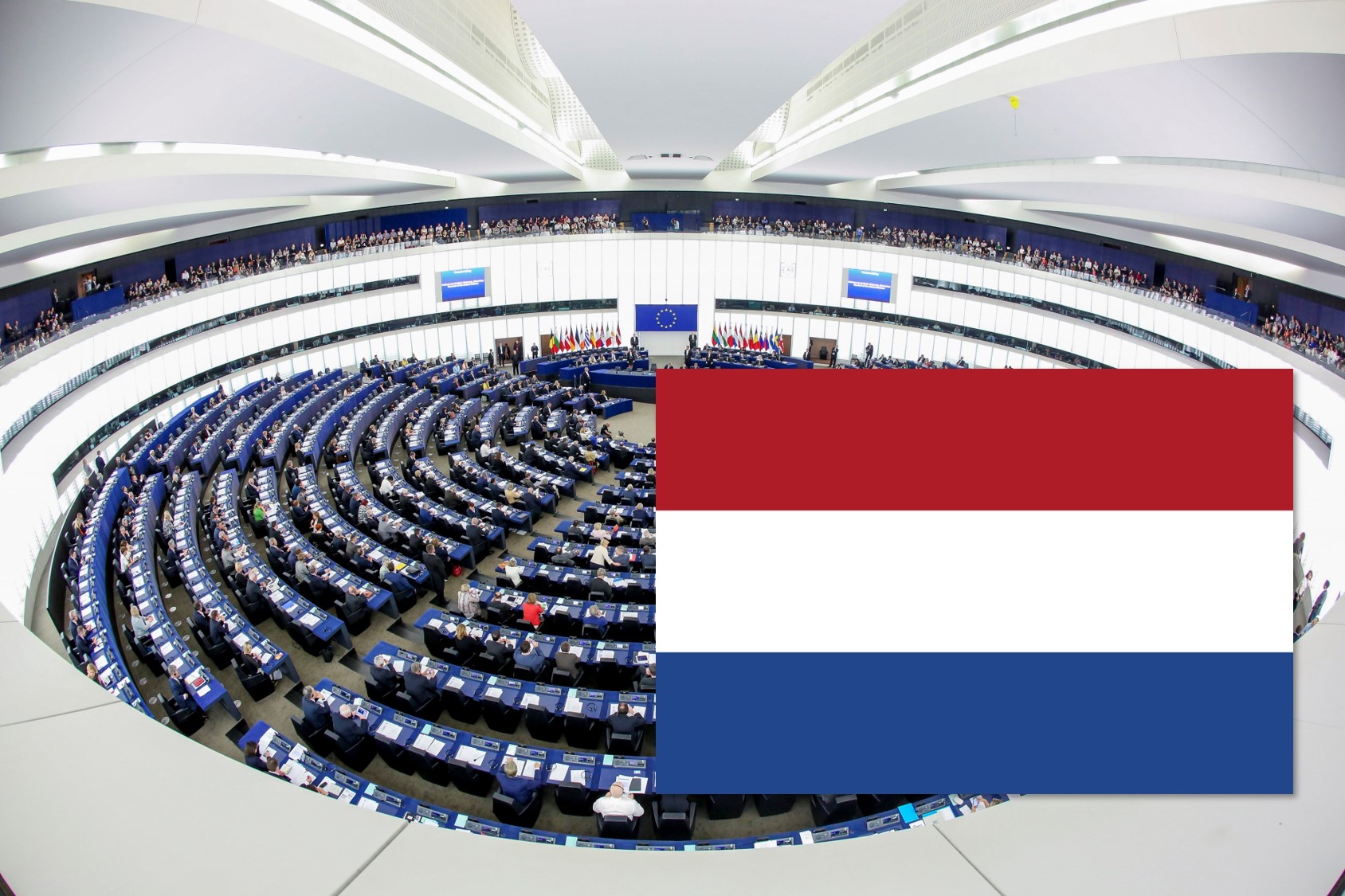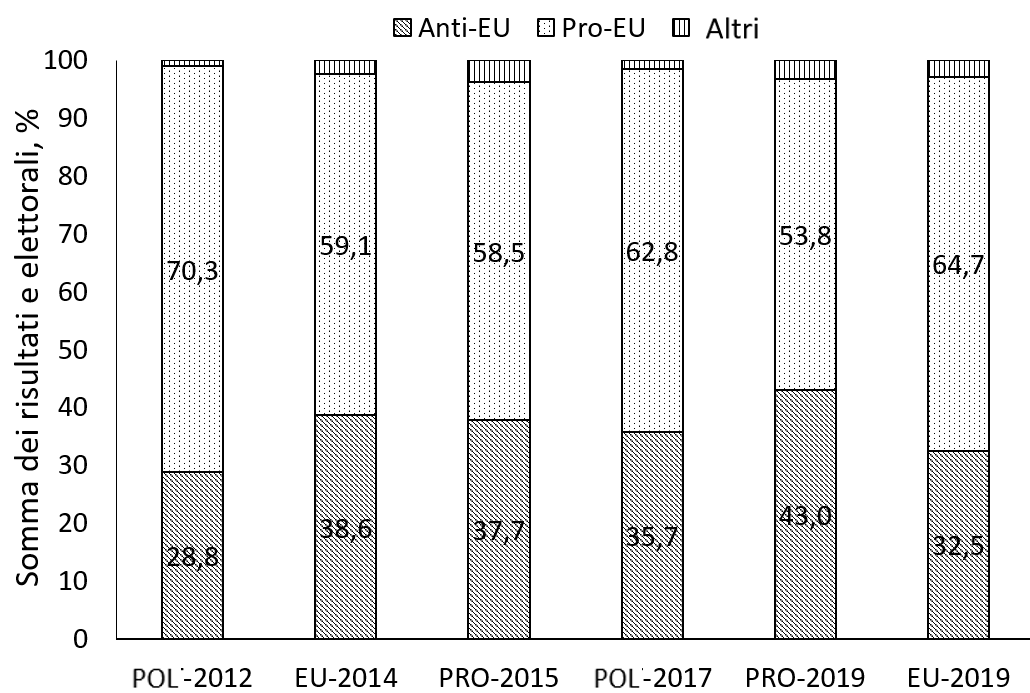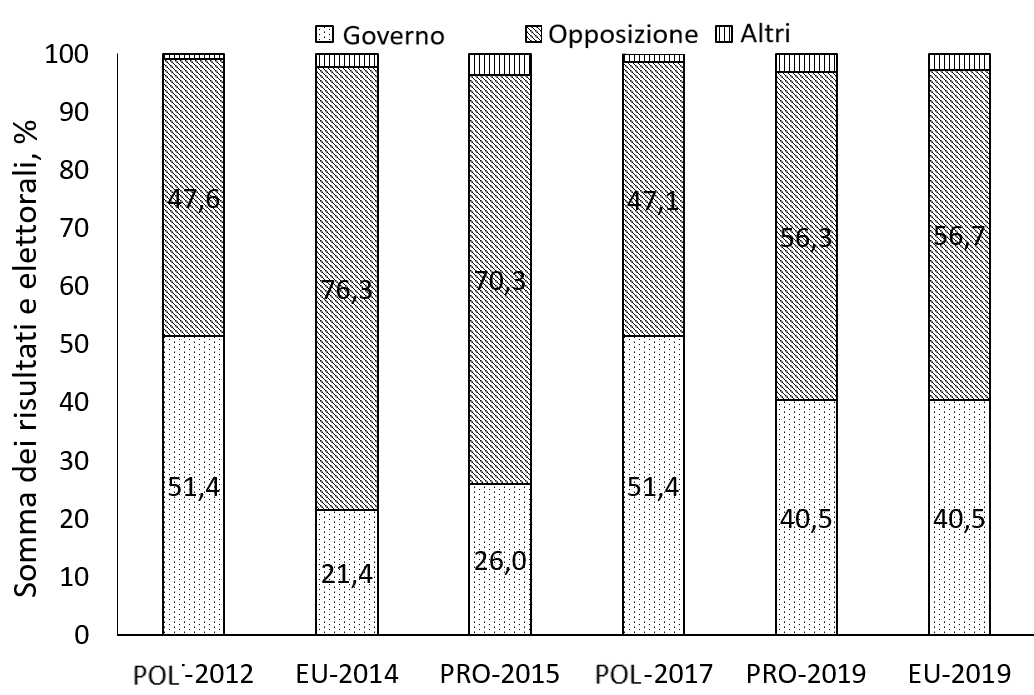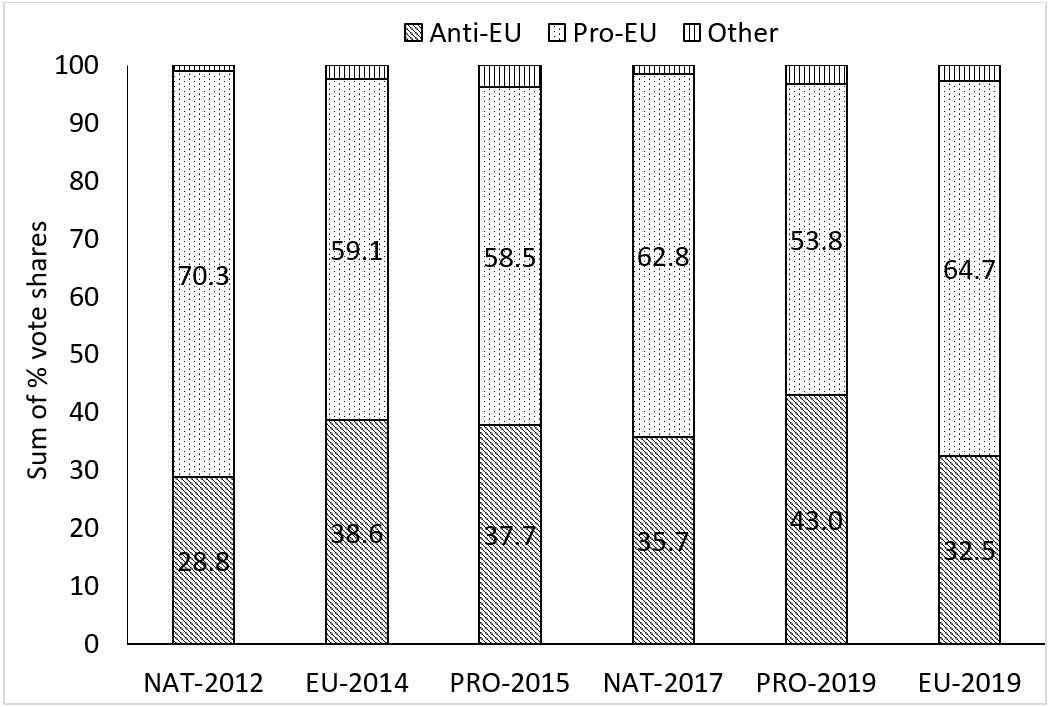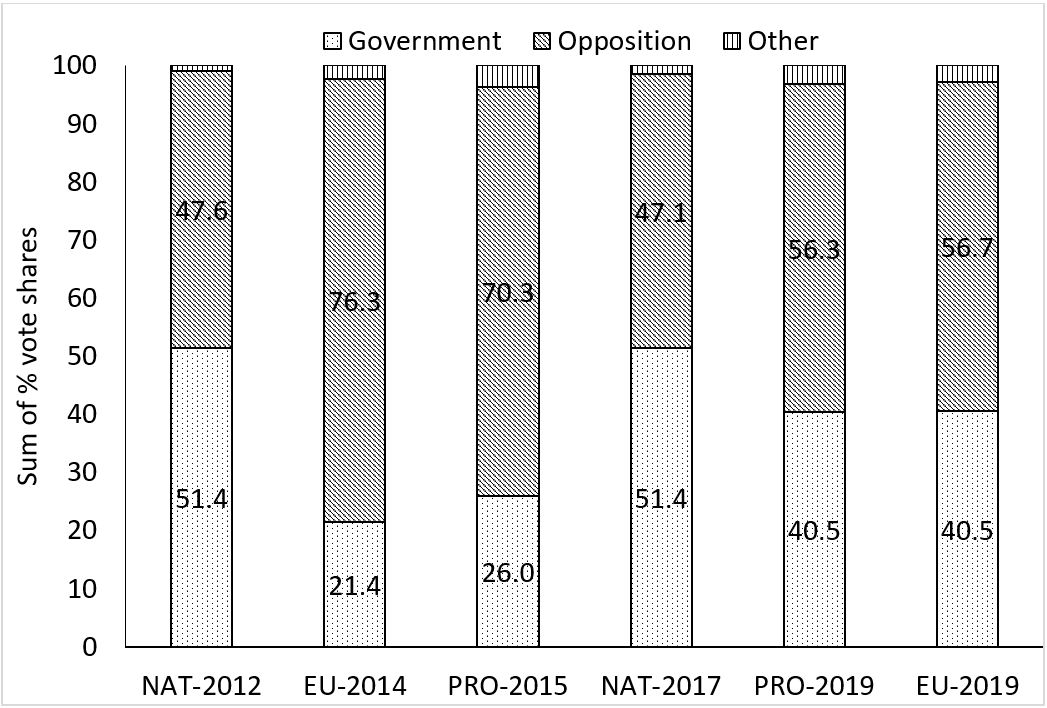Traduzione di Giorgia Ramazzotti.
Introduzione
Paesi Bassi e il Regno Unito sono stati i primi stati membri ad andare al voto martedì 23 maggio 2019, prima degli altri stati membri dell’Unione Europea (UE), che li hanno seguiti il 24 maggio o più tardi. Ci si poteva attendere che il voto in Olanda e Regno Unito avrebbe gettato un’ombra di euroscetticismo sulle elezioni del PE tenute nei giorni a seguire nei 26 stati membri rimanenti, ma non è stato così in Olanda. In realtà, è avvenuto il contrario. Il grande vincitore è stato l’europeista Partito del Lavoro (PvdA) che ha vinto la maggiore percentuale di voti con il 18,9%, 9,5 punti in più rispetto alle elezioni del PE 2014. Il nuovo arrivato e fortemente antieuropeista Forum per la Democrazia (FvD) ha ottenuto il 10,9% dei voti ma questo successo ha avuto conseguenze negative sull’altrettanto antieuropeista Partito della Libertà (PVV), fermo all’8,9% (Tabella 1). Frans Timmermans – primo vice presidente della Commissione Europea – era il candidato leader del PvdA e lo Spitzenkandidat per il gruppo parlamentare del PE Socialisti e Democratici (S&D). Lo Spitzenkandidat (candidato leader per la posizione di presidente della Commissione Europea) è una novità nell’arena elettorale europea introdotta con le elezioni europee del 2014 in un tentativo di aumentare l’interesse e la partecipazione alle elezioni europee. In questo saggio si tenterà di comprendere quanto il risultato delle elezioni europee olandesi possano essere spiegate dall’effetto Timmermans o spitzenkandidat.
Nella prossima sezione verranno discussi brevemente i programmi di partito di tutti i partiti e le tematiche principali della campagna. Nella terza sezione confronterò i risultati delle elezioni del PE 2019 con le precedenti elezioni nazionali (2012 e 2017), provinciali (2015 e 2019) ed europee (2014); questo consentirà di analizzare quanto i risultati delle elezioni del PE 2019 possano essere spiegate dalla crescente importanza dell’UE (gli slittamenti di voto dai partiti europeisti agli antieuropeisti), dalla natura di secondo ordine delle elezioni europee (gli slittamenti di voto da partiti al governo ai partiti di opposizione) o, invece, dall’effetto Timmermans. La sezione finale presenta una breve discussione.
| Tab. 1 – Risultati delle elezioni per il Parlamento Europeo del 2019: Paesi Bassi | |||||
| Partito | Gruppo parlamentare | Voti (VA) | Seggi | Differenza di voti dal 2014 (PP) | Differenza di seggi dal 2014 |
| Partito Laburista (PvdA) | S&D | 18,9 | 6 | +9,5 | +3 |
| Partito Popolare per la Libertà e la Democrazia (VVD) | ALDE | 14,6 | 4 | +2,6 | -1 |
| Appello Cristiano Democratico (CDA) | EPP | 12,1 | 4 | -3,1 | +1 |
| Forum per la Democrazia (FvD) | ECR | 10,9 | 3 | +10,9 | +3 |
| Sinistra Verde (GL) | G-EFA | 10,9 | 3 | +3,9 | +1 |
| Democratici 66 (D66) | ALDE | 7,0 | 2 | -8,5 | -2 |
| Unione Cristiana (CU) – Partito Politico Riformato (SGP) | ECR | 6,8 | 2 | -1,0 | +0 |
| Party per gli Animali (PvdD) | GUE-NGL | 4,0 | 1 | -0,2 | +0 |
| 50Plus (50+) | ⎯ | 3,9 | 1 | +0,2 | +1 |
| Partito per la Libertà (PVV) | NI | 3,5 | 0 | -9,8 | +0 |
| Partito Socialista (SP) | GUE-NGL | 3,4 | 0 | -6,2 | +0 |
| Volt Paesi Bassi (VN) | ⎯ | 1,9 | 0 | +1,9 | +0 |
| DENK | ⎯ | 1,1 | 0 | +1,1 | +0 |
| Altri partiti | ⎯ | 1,0 | 0 | -1,3 | +0 |
| Totale | 100 | 26 | |||
| Affluenza (%) | 41,9 | +4,6 | |||
| Soglia legale di sbarramento (%) | Nessuna (soglia implicita=3,85%) | ||||
Fonti: Parlamento Europeo (2019), NOS (2019).
La campagna elettorale
Ad eccezione del PVV e della lista pan-europeista VN tutti i partiti hanno prodotto dei lunghi programmi per le elezioni europee. Il PVV è assolutamente antieuropeista, come sottolineato in una frase del suo programma, lungo una sola pagina: L’Olanda di nuovo indipendente. Quindi fuori dall’UE (Nederland weer onafhankelijk. Dus uit de EU) (PVV, 2019). FvD è similmente antieuropeista ma il partito vuole tenere un referendum sull’appartenenza all’UE (FvD 2019). Dall’altro lato dello spettro c’è D&S che ha fatto campagna con lo slogan ‘In Europa formiamo il nostro futuro’ (In Europa maken we de toekomst) (D66, 2019), GL che ha introdotto il proprio programma elettorale con la frase ‘L’Unione Europea è indispensabile’ (De Europese Unie is onmisbaar) (GL, 2019), e il partito paneuropeo VN (VN 2019). Tutti gli altri partiti possono essere posizionati tra questi due estremi dal momento che assumono un approccio ‘europeista’ (Vollaard et al., 2016). Questi partiti sono a favore di una collaborazione tra gli stati membri dell’Unione su temi come l’immigrazione, il mercato unico e la sicurezza (CDA, 2019; PvdA, 2019), nonostante alcuni di loro siano chiaramente contro l’estensione e l’ulteriore integrazione dell’EU (CU-SGP, 2019; SP, 2019; VVD, 2019). Alcuni partiti più piccoli non sono antieuropeisti ma vorrebbero riformare significativamente l’UE e vorrebbero che l’UE adottasse particolari policies per ciò che riguarda il benessere degli animali, la cura degli anziani, la protezione dell’ambiente o il consolidamento di una società multiculturale (50Plus, 2019; DENK, 2019; PvdD, 2019).
Non è usuale per i partiti politici olandesi scegliere delle figure politiche chiave a guida delle liste dei partiti politici in un contesto di elezioni europee (Vollaard et al., 2016). Le elezioni del PE 2019 non sono state un’eccezione, con l’esclusione del PVdA la cui lista era guidata da Frans Timmermans che, con una lunga esperienza da membro del parlamento e da ex segretario di stato e ministro degli esteri (Parlement.com, 2019a), è un politico molto rinomato in Olanda. Nonostante la sua statura politica in Olanda e l’attenzione posta sulla sua partecipazione al dibattito Spitzenkandidaten tenutosi a Maastricht (NRC, 2019a; Trouw, 2019a; Volkskrant, 2019a), Timmermans non ha ricevuto molta copertura mediatica durante la campagna. Ad esempio, uno dei principali quotidiani ha pubblicato interviste con i numeri uno delle liste per FvD e D66 nella settimana finale della campagna (De Volkskrant, 2019b, 2019c). Un altro esempio è il dibattito testa a testa tra il presidente-ministro Mark Rutte (VVD) e Thierry Baudet (FvD) che è stato trasmesso in TV la sera prima del giorno delle elezioni e che ha attratto 1.5 milioni di spettatori (AD 2019, NU nl. 2019). Nonostante la limitata attenzione mediatica, il PvdA è diventato il chiaro vincitore delle elezioni del PE 2019 (Tabella 1), un dato che rende il risultato elettorale piuttosto importante perché non era previsto affatto dalle stime di sondaggio (Ipsos, 2019a; NRC, 2019b; Volkskrant, 2019d; Trouw, 2019b).
Il risultato elettorale: l’aumento della rilevanza dell’UE, uno slittamento anti-governativo o l’effetto Timmermans?
La Tabella 2 confronta i risultati delle elezioni europee 2019 con i risultati delle provinciali del 2015, le nazionali del 2012 e 2017 e le elezioni del PE 2014. Il confronto rivela quanto le elezioni europee 2019 si differenzino dagli altri tipi di elezioni e in relazione alle tendenze elettorali generali. Il successo del PvdA alle elezioni del PE del 2019 posiziona il partito vicino al livello di voti che ottenne alle elezioni nazionali del 2012. È troppo presto per dire se è l’inizio di un recupero ma il numero effettivo di partiti (ENP) –una misura che indica quanto è frammentato il voto tra i partiti e che prende in considerazione il numero e le proporzioni di voti ricevuti (Laakso and Taagepera, 1979)– indica che il voto non è diventato ulteriormente frammentato tra i partiti. Invece, bisogna guardare ai cambiamenti aggregati nelle preferenze di voto tra le elezioni per comprendere il risultato delle elezioni del PE 2019.
Tab. 2 – Risultati elettorali dal 2012, valori percentuali sui voti validi
| Politiche | Europee | Provinciali | Politiche | Provinciali | Europee | |
| 12/9/12 | 22/5/14 | 18/5/15 | 15/3/17 | 20/3/19 | 23/5/19 | |
| PVV | 10,1 | 13,3 | 11,7 | 13,1 | 6,9 | 3,5 |
| FvD | ⎯ | ⎯ | ⎯ | 1,8 | 14,5 | 10,9 |
| CU-SGP | 5,2 | 7,8 | 7,5 | 5,5 | 7,6 | 6,8 |
| VVD | 26,6 | 12,0 | 15,9 | 21,3 | 14,0 | 14,6 |
| CDA | 8,5 | 15,2 | 14,7 | 12,4 | 11,1 | 12,1 |
| D66 | 8,0 | 15,5 | 12,5 | 12,2 | 7,8 | 7,0 |
| PvdA | 24,8 | 9,4 | 10,1 | 5,7 | 8,5 | 19,0 |
| GL | 2,3 | 7,0 | 5,4 | 9,1 | 10,8 | 10,9 |
| SP | 9,7 | 9,6 | 11,7 | 9,1 | 5,9 | 3,4 |
| PvdD | 1,9 | 4,2 | 3,5 | 3,2 | 4,4 | 4,0 |
| 50Plus | 1,9 | 3,7 | 3,4 | 3,1 | 3,6 | 3,9 |
| DENK | ⎯ | ⎯ | ⎯ | 2,1 | 1,7 | 1,1 |
| Altri partiti | 1,0 | 2,3 | 3,7 | 1,5 | 3,2 | 2,8 |
| Affluenza (%) | 74,6 | 37,3 | 47,8 | 81,6 | 56,2 | 41,9 |
| ENEP[1] | 5,9 | 8,9 | 8,9 | 8,4 | 10,4 | 8,9 |
Fonti: Parliamento Europeo (2019), Kiesraad (2019), NOS (2019).
La rilevanza dell’UE
La teoria della salienza dell’UE suggerirebbe che lo slittamento dei voti può essere attribuito ad un aumento della rilevanza dell’UE, che produce come risultato un’affluenza più alta e causa un movimento degli elettori dai partiti europeisti a quelli antieuropeisti, con l’eccezione dei Verdi che anche dovrebbero vincere una parte dei voti (Viola 2016). La Figura 1 mostra le percentuali di voto per i partiti antieuropeisti ed europeisti nelle elezioni nazionali, provinciali e europee dal 2012. Nelle elezioni del PE 2019 i partiti antieuropeisti hanno vinto una percentuale di voti complessiva del 32,5% che è piuttosto simile –entro una deviazione del 6%– alle percentuali combinate che questi partiti hanno ottenuto nelle precedenti elezioni europee, nazionali e provinciali, eccetto le provinciali del 2019. Un altro segno che l’aumento della rilevanza dell’UE non è un probabile fattore esplicativo è dato dai tassi di affluenza mostrati nella Tabella 2. Le elezioni del PE 2019 sono state segnate dall’affluenza più alta nelle elezioni europee degli ultimi venti anni, tuttavia in Olanda un’affluenza più alta è parte di una tendenza generale piuttosto che un segnale di aumento della rilevanza dell’UE. L’affluenza alle elezioni nazionali del 2017 è stata di 7 punti percentuali più alta di quella delle elezioni nazionali del 2012 e l’affluenza alle elezioni provinciali del 2019 è stata di 8,4 punti percentuali più alta rispetto alle elezioni provinciali del 2015. Al massimo, il piccolo aumento di 4,6 punti percentuali dell’affluenza alle elezioni del PE del 2019 rispetto alle elezioni europee del 2014 è segno di una bassa rilevanza. Infine, i partiti Verdi (GL e PydD) non hanno aumentato significativamente le loro percentuali di voto alle europee e alle provinciali del 2019 rispetto alle elezioni nazionali del 2017 (Tabella 2).
Fig. 1 – Risultati elettorali per i partiti anti-UE e pro-UE nelle elezioni politiche, provinciali ed europee
Slittamento anti-governativo
Lo slittamento delle percentuali di voto può risultare da uno slittamento a sfavore del partito in carica al governo considerando che il PvdA è stato al governo nazionale da dopo le elezioni nazionali del 2012 ma all’opposizione da dopo le elezioni nazionali del 217. Il ‘voto punitivo’ per i partiti di governo nelle elezioni europee e sub-nazionali è attribuita alla natura di secondo ordine di queste elezioni (Viola 2016). Le elezioni nazionali di primo ordine sono concepite dagli elettori, i partiti e i media come contesti più importanti delle elezioni europee e sub-nazionali perché c’è di più ‘in gioco’ considerando che i governi nazionali prendono decisioni su questioni essenziali come le tasse, l’assistenza sociale, e la politica estera (Rei e Schmitt, 1980). La Figura 2 mostra le percentuali di complessive dei partiti al governo e dei partiti di opposizione nel le elezioni nazionali, provinciali ed europee dal 2012. I partiti di governo hanno ricevuto solo metà delle loro percentuali di voto del 2012 alle elezioni europee del 2014 e alle provinciali del 2015, cosa che indica che le elezioni europee e provinciali sono entrambe concepite come elezioni di secondo ordine. In questa luce, la perdita di dieci punti percentuali per i partiti di governo alle europee 2019 e alle elezioni provinciali rispetto alle elezioni nazionali del 2017, può essere considerata piuttosto modesta.
Fig. 2 – Risultati elettorali per i partiti di governo e di opposizione nelle elezioni politiche, provinciali ed europee
Effetto Timmermans (Spitzenkandidaten)
Nonostante la tempistica ravvicinata delle elezioni provinciali ed europee del 2019, la Tabella 2 rivela slittamenti di voto aggregati significativi tra i partiti. Il grande vincitore delle elezioni provinciali del 2019 è stato FvD che ha ottenuto 12.8 punti percentuali in più rispetto alle elezioni nazionali del 2012. Più probabilmente, gli elettori si sono spostati dal VVD che ha perso 7.3 punti percentuali e dal PVV che ha perso 6.1 punti rispetto alle elezioni nazionali del 2012. Le elezioni provinciali e europee 2019 mostrano risultati piuttosto simili, a parte la straordinaria conquista del PvdA che passa dall’8,5 al 19,0%. I principali perdenti sono stati l’FvD (-3,6%), il PVV (-3,3%) e il SP (-2,5%), la cui perdita di -9,6 punti percentuali è vicina al guadagno di voti del PvdA di 10,5 punti. Questi spostamenti di voto sono segnali di un effetto spitzenkandidaten per cui Timmermans è stato capace di attrarre elettori dall’intero spettro politico?
La Tabella 3 mostra le percentuali di voto delle elezioni tenutesi dal 2012 per gli otto partiti più grandi nella provincia di Limburg. Questa provincia è interessante perché è considerata come la ‘casa’ di Timmermans. Frans Timmermans è nato a Maastricht, la capitale di provincia di Limburg, ha frequentato la scuola secondaria a Heerlen (una città di Limburg) dove possiede ancora una casa, ed è stato candidato per diventare Commissario del Re della provincia di Limburg nel 2011 ma non ha ottenuto l’incarico (Parlement.com, 2019a). Frans Timmermans è conosciuto per essere poliglotta e oltre a parlare l’olandese e il dialetto di Limburg parla anche l’inglese, il francese, il tedesco, l’italiano ed il russo. È dichiaratamente un europeista unionista e ha lanciato la sua campagna come Spitzenkandidaten di S&D per le elezioni del PE 2019 a Herleen nella provincia di Limburg. Frans Timmermans ha chiaramente dato importanza durante la campagna a Limburg, una regione di confine dove storicamente si sono intrecciate le interazioni tra il Belgio e la Germania. Ad esempio, Timmermans ha iniziato il suo discorso di accettazione come candidato leader con dei riferimenti a suo nonno e al suo bisnonno che si trasferirono dalla Germania ad Heerlen per lavorare in miniera (Timmermans 2019).
Tab. 3 – Risultati elettorali dal 2012 nel Limburgo, valori percentuali sui voti validi[2]
| Partito | Politiche 2012 | Europee 2014 | Provinciali 2015 | Politiche 2017 | Provinciali 2019 | Europee 2019 |
| PVV | 17,7 | 20,8 | 17,8 | 19,6 | 13,6 | 6,2 |
| FvD | ⎯ | ⎯ | ⎯ | 2,0 | 14,6 | 11,4 |
| VVD | 22,7 | 20,8 | 11,5 | 17,9 | 10,2 | 8,9 |
| CDA | 9,7 | 12,2 | 22,9 | 14,9 | 18,7 | 14,7 |
| PvdA | 21,8 | 7,7 | 7,3 | 4,0 | 6,5 | 28,7 |
| D66 | 6,3 | 12,2 | 9,4 | 10,6 | 5,8 | 4,3 |
| GL | 1,8 | 0,9 | 3,9 | 10,6 | 8,4 | 7,0 |
| SP | 14,4 | 12,7 | 15,5 | 13,7 | 8,7 | 3,9 |
| Totale | 94,4 | 87,2 | 88,4 | 93,3 | 86,4 | 85,2 |
Fonti: Kiesraad (2019); nlverkiezingen.com (2019); NOS (2019).
Dalla Tabella 3 si può osservare che gli otto maggiori partiti sono capaci di attrarre quasi il 95% del voto durante le elezioni nazionali ma che durante le elezioni europee e provinciali perdono collettivamente quasi il 10% dei voti (le percentuali sono rispettivamente 85,2% e 86,4%). Questo sottolinea la natura di secondo ordine di questi contesti in cui gli elettori tendono a supportare piccoli partiti e nuovi partiti perché si spostano dal voto strategico ad un voto sincero (Marsh e Mihaylov 2010). Gli elettori di Limburg si sono comportanti similmente agli elettori olandesi più in generale ma i cambiamenti di voto aggregato sono stati di maggiore entità. Ciò che si distingue nella Tabella 3 è che quando le elezioni provinciali ed europee vengono confrontate tra loro, le perdite di percentuali di voto per il PVV (-7,3), FvD (-3,1) , VVD (-1,2) CDA (-3,9) D66 (-1,5) e SP (-4,8) insieme totalizzano un -23,4% che è molto vicino al guadagno di 22,2 punti percentuali di PvdA. Nonostante la simile natura di elezioni di secondo ordine sia per le europee che per le provinciali 2019, si può osservare un chiaro effetto Timmermans (Spitzenkandidaten). In risposta alla domanda su quanto il capo della lista di partito fosse stato importante per la scelta di voto, non meno del 48% degli elettori di PvdA ha indicato che era importante mentre la seconda percentuale più alta è stato un magro 18% registrato per gli elettori di PVV (Ipsos, 2019b). Timmermans sembra essere stato capace di attrarre elettori da tutto lo spettro politico destra-sinistra e i suoi elettori sembrano meno preoccupati di punire i partiti al governo o di votare secondo la loro opinione sulle questioni dell’UE (vedi anche Ipsos, 2019b).
Discussione
L’analisi in questo contributo suggerisce chiaramente come l’effetto Timmermans (Spitzenkandidaten) abbia avuto un ruolo sui risultati delle elezioni 2019 del Parlamento Europeo in Olanda. La Tabella 3 rivela spostamenti significativi di voto a Limburg che non sono osservati nei dati nazionali aggregati (Tabella 2). Ad esempio, il PvdA ha perso il 14,1 punti percentuali quando le elezioni del PE 2014 si confrontano con le elezioni nazionali del 2012. I beneficiari sono stati il D66 (5,8%) e il PVV (3,1%). Spostamenti significativi di elettori sono individuabili anche quando le elezioni provinciali del 2015 si confrontano con le elezioni europee del 2014. In questo confronto il CDA è chiaramente il vincitore (10,8%) mentre il VVD è stato significativamente il perdente (9,2%). Sembra che gli elettori di Limburg (e di tutta l’Olanda, vedi Tabella 2) sia di sinistra sia di destra stiano fluttuando e possano essere mobilitati da un candidato attraente che raggiunge gli elettori portando avanti campagne locali (vedi anche Gatterman et al. 2016; Schmitt et al. 2015). Questa sarebbe un’ipotesi interessante da esplorare ulteriormente attraverso un’analisi dei sondaggi elettorali che permetterebbero di arrivare alle motivazioni che sottostanno alle scelte di voto.
Riferimenti
Braun, D. e Popa, S. A. (2018). This time it was different? The salience of the Spitzenkandidaten system among European parties. West European Politics, 41(5), 1125-1145.
Gattermann, K., de Vreese, C. e van der Brug, W. (2016). Evaluations of the Spitzenkandidaten: The role of information and news exposure in citizens’ preference formation. Politics and Governance, 4(1), 37-54.
Hobolt, S. B. (2014). A vote for the President? The role of Spitzenkandidaten in the 2014 European Parliament elections. Journal of European Public Policy, 21(10), 1528-1540.
Ipsos (2019b). EP19. Verkiezingsonderzoek Ipsos in opdracht van de NOS. Amsterdam 29 mei 2019. Retrieved May 30, 2019 from: https://www.ipsos.com/sites/default/files/2019-05/19020845_ipsos_ep19_v1.3.pdf.
Laakso, M. e Taagepera, R. (1979). Effective number of parties: A measure with Application to West Europe. Comparative Political Studies, 12(3), 3-27.
Marsh, M. e Mihaylov, S. (2010). European Parliament elections and EU governance, Living Reviews in European Governance, 5(4). Retrieved from: https://www.livingreviews.org/lreg-2010-4.
Reif, K. e Schmitt, H. (1980). Nine second-order national elections – A conceptual framework for the analysis of European election results. European Journal of Political Research, 8(10), 3-44.
Schmitt, H., Hobolt, S. e Popa, S. A. (2015). Does personalization increase turnout? Spitzenkandidaten in the 2014 European Parliament elections. European Union Politics, 16(3), 347-368.
Viola, D. M. (2016). European Parliament elections theories. In D. M. Viola (Ed.), Routledge handbook of European elections (39-48). London: Routledge.
Vollaard, H., Voerman, G. e van de Waller, N. (2016). The Netherlands. In D. M. Viola (Ed.), Routledge handbook of European elections (167-188). London: Routledge.
European Union Election Party Manifestoes
50Plus (50+) (2019). Onze toekomst in Europa. Solidair met jong en oud. Geef 50-plussers een stem in het Europees Parlement. Programma voor de 9e verkiezingen voor het Europees Parlement op 23 mei 2019. Retrieved from: https://50pluspartij.nl/images/2018/september_oktober/50PLU-verkiezingsprogramma-EP-20180917.pdf.
ChristenUnie (CU) – Staatkundig Gereformeerde Partij (SGP) (2019). ‘Naar de kern’. Verkiezingsprogramma ChristenUnie en SGP Europees Parlement 2019-2024. Retrieved from: https://www.christenunie.nl/l/library/download/urn:uuid:3fe98a0a-377e-4a3b-90d9-9dae554dc2d3/verkiezingsprogramma+ep2019+online.pdf.
Christen-Democratisch Appèl (CDA) (2019). Beschermen wat van waarde is. Daarom een sterk Europa. Europees verkiezingsprogramma 2019-2014. Retrieved from: https://d2vry01uvf8h31.cloudfront.net/CDA/Documenten/2019/CDAEUvkp%5B2019-2024%5D-digitaal_01.pdf.
Democraten 66 (D66) (2019). In Europa maken we de toekomst. Definitief programma D66 verkiezingen Europees Parlement 2019. Retrieved from: https://verkiezingsprogramma.d66.nl/content/uploads/sites/45/2019/04/D66_verkiezingsprogramma_EP2019.pdf.
Denk (DENK) (2019). Denkend aan Europa. Verkiezingsprogramma Europees Parlement 2019-2024. Retrieved from: https://denkeuropa.eu/Verkiezingsprogramma-Europees-Parlement-2019-2024.pdf.
Forum voor Democratie (FvD) (2019). Waar staat het Forum voor Democratie in het politieke spectrum?. Retrieved from: https://forumvoordemocratie.nl/standpunten/europese-unie.
GroenLinks (GL) (2019). Voor verandering. Verkiezingsprogramma Europese verkiezingen 2019. Retrieved from: https://groenlinks.nl/sites/groenlinks.nl/files/Europees_verkiezingsprogramma_2019%20%281%29.pdf.
Partij van de Arbeid (PvdA) (2019). Zeker van een eerlijk, vrijd en duurzaam Europa. Verkiezingsprograma van de PvdA voor de Europese Parlementsverkiezingen 2019. Retrieved from: https://www.pvda.nl/wp-content/uploads/2019/02/EU-verkiezingsprogramma-DEF.pdf.
Partij voor de Dieren (PvdD) (2019). Plan B voor Europa. Verkiezingsprogramma Europees Parlement 2019. Retrieved from: https://www.partijvoordedieren.nl/uploads/algemeen/PvdD-19.067-Verk.-progr.-EP-2019.pdf.
Partij voor de Vrijheid (PVV) (2019). Nederland weer van ons! Concept – Verkiezingsprogramma PVV 2017-2021. Retrieved from: https://pvv.nl/visie.html.
Socialistische Paritj (SP) (2019). Breek de macht van Brussel. Voor een rechtvaardige EU. Programma Europese verkiezingen 2019. Retrieved from: https://www.sp.nl/sites/default/files/breek_de_macht_van_brussel_0.pdf.
Volt Nederland (VN) (2019). De 5 Hoofdstandpunten. Retrieved from: https://www.voltnederland.org/standpunten.
Volkspartij voor Vrijheid en Democratie (VVD) (2019). Focus en Leef. Voor een sterk Nederland in een veilig Europa. Verkiezingsprogramma Europees Parlement 2019. Retrieved from: https://www.vvd.nl/verkiezingsprogramma_s/.
Siti web
AD (2019, May 23). Helft TV-kijkers stemt af op debat Baudet versus Rutte. Retrieved from: https://www.ad.nl/show/helft-tv-kijkers-stemt-af-op-debat-baudet-versus-rutte~a7c87941/.
CBS (2019). Centraal Bureau voor de Statistiek. StatLine. Retrieved from: https://statline.cbs.nl/Statweb/default.aspx
CHES (2019). Chapel Hill Expert Survey Dataset. Retrieved from: https://www.chesdata.eu/ches-stats.
European Parliament (2019). 2019 European election results. Retrieved from: https://election-results.eu/national-results/netherlands/2019-2024/.
Ipsos (2019a). Politieke barometer week 21. Retrieved from: https://www.ipsos.com/nl-nl/politieke-barometer-week-21.
Kiesraad (2019). Databank Verkiezingsuitslagen. Retrieved from: https://www.verkiezingsuitslagen.nl/verkiezingen.
nlverkiezingen.com (2019). Nederlandse verkiezingsuitslagen 1918-nu. Retrieved from: https://www.nlverkiezingen.com.
NOS (2019a). Bekijk hier alle uitslagen van de EU-verkiezingen. Retrieved from: https://nos.nl/artikel/2285797-bekijk-hier-alle-uitslagen-van-de-eu-verkiezingen.html.
NRC (2019a, April 29). Campagne voeren zonder de grote concurrent. Retrieved from: https://www.nrc.nl/nieuws/2019/04/29/debat-zonder-de-grote-concurrent-a3958576.
NRC (2019b, May 23). PvdA wordt onverwacht de grootste. Retrieved from: https://www.nrc.nl/nieuws/2019/05/23/pvda-wordt-onverwacht-de-grootste-a3961417.
NU.nl (2019, May 23). Anderhalf miljoen kijkers voor debat tussen Bauder en Ruttue in Pauw. Retrieved from: https://www.nu.nl/media/5905041/anderhalf-miljoen-kijkers-voor-debat-tussen-baudet-en-rutte-in-pauw.html.
Parlement.com (2019a). Parlement.com. Retrieved from: https://www.parlement.com/id/vg09llk9rzrp/f_c_g_m_frans_timmermans
Parlement.com (2019b). Parlement.com. Retrieved from: https://www.parlement.com/id/vh8lnhrp1x03/kabinetten_1945_heden.
Timmermans, F. (2019). Kandidaatsspeech Frans Timmermans. Spoken out on Wednesday 10 October 2018. Retrieved from: https://www.pvda.nl/politici/frans-timmermans/.
Trouw (2019a, April 29). Nederlanders voeren boventoon in eerste Europees verkiezingsdebat. Retrieved from: https://www.trouw.nl/democratie/nederlanders-voeren-boventoon-in-eerste-europees-verkiezingsdebat~a1a7eb9d/.
Trouw (2019b, May 23). Het Timmermanswonder maakt van de PvdA de grote Winnaar. Retrieved from: https://www.trouw.nl/democratie/het-timmermanswonder-maakt-van-pvda-onverwacht-de-grote-winnaar-~a2303790/.
Volkskrant (2019a, April 29). Het eerste debat tussen lijsttrekkers is symbolisch foor de Europese politiek. Retrieved from: https://www.volkskrant.nl/nieuws-achtergrond/het-eerste-debat-tussen-lijsttrekkers-is-symbolisch-voor-de-europese-politiek~b7350fd6/.
Volkskrant (2019b, May 17). De Europese Unie is het vehikel van onze soevereiniteit. Retrieved from: https://www.volkskrant.nl/nieuws-achtergrond/de-europese-unie-is-het-vehikel-van-onze-soevereiniteit~b5daf610/.
Volkskrant (2019c, May 17). Als we doorgaan op deze weg, is de Unie ten dode opgeschreven. Retrieved from: https://www.volkskrant.nl/nieuws-achtergrond/als-we-doorgaan-op-deze-weg-is-de-unie-ten-dode-opgeschreven~ba7ca971/.
Volkskrant (2019d, May 24). Wat zit er achter het Timmermans-effect?. Retrieved from: https://www.volkskrant.nl/nieuws-achtergrond/wat-zit-er-achter-het-timmermans-effect~bccb88d5/.
[1] Laakso and Taagepera (1979)
[2] Le quote di voto delle europee 2019 sono stimate sulla base delle percentuali di voto nei comuni (N = 31), ponderate per la dimensione demografica del comune e l’affluenza alle urne.
